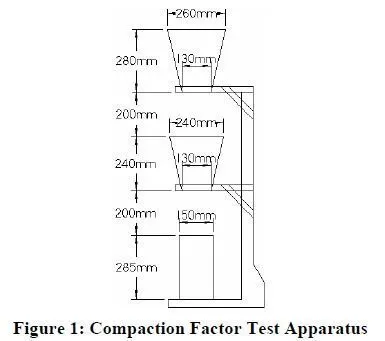A system to monitor and control the quality of concrete throughout production based on rheological properties was recently developed and patented (US patent 6,227,039). The system consists of multiple test devices that measure rheological properties of concrete at various stages of concrete mixture proportioning, production, transport, and placement. Each device is used as appropriate; not all devices are used for a given concrete mix. At a minimum, testing is conducted during the mix proportioning process, at the concrete plant during concrete batching and mixing, and away from the concrete plant (either at the jobsite or during transit).
The first device described in the patent document consists of an inverted U-shaped box mounted within a rigid frame, as shown in Figure 22. The entire device is submerged in a sample of fresh concrete. A piston, designated as 42, moves up and down to force fresh concrete in and out of the box. Multiple stress and pressure sensors throughout the device monitor the forces generated in the test device and in the concrete. To measure the effect of vibration on the concrete, a vibrator (12) can be used. A data collection system logs data from all sensors for further analysis. The patent document suggests two methods to measure workability with this device: by determining the time required for the test device to produce a given deformation under a constant force or by determining the resistance to shear at a given rate of deformation.
The second embodiment of the test device is shown in Figure 23. The U-shaped portion of the box is immersed in a sample of concrete. The rotation of the paddle, forces concrete upwards in the box and against stress sensors (132). A tachometer and an ammeter measure the performance of the electric motor. As before, the data from the device is sent to a data collection system for further analysis.
A third test device measures the performance of concrete pumps in order to quantify workability. For pumps consisting of a screw-type device, an ammeter measures the current used by the pump and a tachometer measures the speed of rotation of the screw. For piston-type hydraulic pumps, a manometer measures the changing hydraulic pressure in the pump and an electronic ruler measures the displacement of the piston. After concrete leaves the hopper, additional sensors mounted to the inside of the exit pipe measure changes in pressure as concrete flows through the pipe.
The fourth test device, which is applicable to pumped concretes, is essentially a venturi meter. The diameter of a pipe in a pumping system is narrowed. Pressure sensors monitor the changing stress states as the concrete moves through the narrowed section of the pipe. The patent document does not indicate how this data is used.
The fifth test device described in the patent document consists of a flexible strip inserted into a 90 degree pipe bend within a pumping system. Sensors mounted to the flexible strip measure the loss in pressure and the change in stress states as the concrete moves through the bend.
To measure concrete at different stages of concrete production further, the patent document suggests that previously described devices, shown in Figure 22 and Figure 23, can be used in stationary paddle mixers and mobile ready-mix trucks.
A final system described in the patent document applies to the production of concrete blocks. Under the described system, blocks are randomly selected from a production line and measured for size and mass. The fresh concrete compressive strength of each block is measured. The rheology of the mix can be measured using the first device described in the patent document, shown in Figure 22. It is not clear that this particular device is applicable to low and zero slump concrete mixtures typically used in the casting of concrete blocks.
The output of each test device is used to create a rheological profile of the concrete mixture. Unlike other devices that relate shear stress to shear rate, the rheological profile generated in accordance with the patent document relates shear stress to shear deformation. No dimensions for any of the devices are provided in the patent document. Each device in the patent document is described with progressively less detail.
It must be noted that the patent claims to cover not just the test devices but also the system for monitoring workability from mix proportioning to concrete placement. The system begins with the mix design process. Multiple mixes are prepared in order to develop a mix with desired rheological properties. At the concrete plant and in the field, the concrete batch can be modified as necessary until the rheological parameters of the mix match the desired design properties.
An initial patent (US patent 5,948,970) was granted in 1999 and a continuation of the original patent was granted in 2001. At the time of this writing, it is not known whether this system is sold commercially.
Advantages:
The system monitors the rheology of concrete throughout the production process.
Mixture designs and later changes to mix designs can be made to optimize rheology and hardened concrete properties and to minimize costs.
Disadvantages:
Although the system allows rheology to be measured throughout production, different devices are used. The results from one device should generally not be directly compared to the results of other test devices.
The devices typically measure shear stress versus shear deformation to develop a rheological profile, instead of the more conventional relationship between shear stress and shear rate.
The devices used in the system appear to be appropriate only for concretes with moderate to high slumps.
